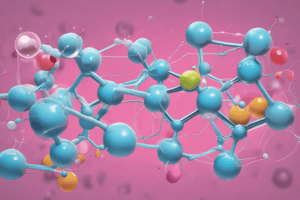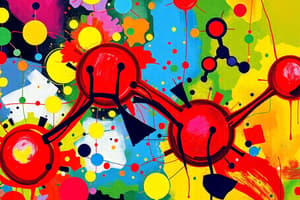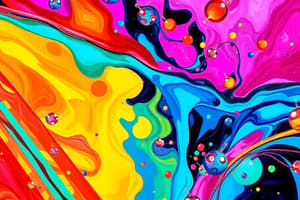Podcast
Questions and Answers
What type of bond is formed when a hydrogen atom is covalently bonded to one electronegative atom and attracted to another electronegative atom?
What type of bond is formed when a hydrogen atom is covalently bonded to one electronegative atom and attracted to another electronegative atom?
- Covalent bond
- Ionic bond
- Metallic bond
- Hydrogen bond (correct)
Which elements are typically involved as electronegative partners in hydrogen bonding within living cells?
Which elements are typically involved as electronegative partners in hydrogen bonding within living cells?
- Phosphorus and selenium
- Oxygen and nitrogen (correct)
- Carbon and sulfur
- Fluorine and chlorine
What phenomenon explains the attractions between molecules that occur when electrons are unevenly distributed?
What phenomenon explains the attractions between molecules that occur when electrons are unevenly distributed?
- Van der Waals interactions (correct)
- Covalent bonds
- Ionic interactions
- Hydrogen bonds
What primarily determines a molecule's shape and, subsequently, its function?
What primarily determines a molecule's shape and, subsequently, its function?
What are the starting molecules of a chemical reaction called?
What are the starting molecules of a chemical reaction called?
Which of the following statements about chemical reactions is correct?
Which of the following statements about chemical reactions is correct?
What is the process of converting carbon dioxide and water into glucose and oxygen called?
What is the process of converting carbon dioxide and water into glucose and oxygen called?
Why do opiates and naturally produced endorphins have similar effects in the brain?
Why do opiates and naturally produced endorphins have similar effects in the brain?
What primarily determines the chemical behavior of an atom?
What primarily determines the chemical behavior of an atom?
What are valence electrons?
What are valence electrons?
Which statement is true about atoms with a full valence shell?
Which statement is true about atoms with a full valence shell?
What is the maximum number of electrons that can occupy a single orbital?
What is the maximum number of electrons that can occupy a single orbital?
What type of bond involves the sharing of a pair of valence electrons?
What type of bond involves the sharing of a pair of valence electrons?
How is a single covalent bond represented in structural formulas?
How is a single covalent bond represented in structural formulas?
What do covalent bonds result in when formed between atoms?
What do covalent bonds result in when formed between atoms?
In a double covalent bond, how many pairs of valence electrons are shared?
In a double covalent bond, how many pairs of valence electrons are shared?
Which statement accurately describes an element?
Which statement accurately describes an element?
What defines a compound in chemistry?
What defines a compound in chemistry?
Which elements make up the majority of living matter?
Which elements make up the majority of living matter?
What is the role of trace elements in organisms?
What is the role of trace elements in organisms?
Which of the following particles has a negative charge?
Which of the following particles has a negative charge?
What is the primary function of neutrons within an atom?
What is the primary function of neutrons within an atom?
What describes the structure surrounding the atomic nucleus?
What describes the structure surrounding the atomic nucleus?
Why are the masses of electrons often ignored in calculations of atomic mass?
Why are the masses of electrons often ignored in calculations of atomic mass?
What does an element's atomic number represent?
What does an element's atomic number represent?
Which statement accurately describes isotopes?
Which statement accurately describes isotopes?
How is the half-life of an isotope best described?
How is the half-life of an isotope best described?
What is atomic mass primarily based on?
What is atomic mass primarily based on?
What role do radioactive tracers play in medicine?
What role do radioactive tracers play in medicine?
In terms of potential energy, how does the position of electrons relate to the nucleus?
In terms of potential energy, how does the position of electrons relate to the nucleus?
What occurs during radiometric dating?
What occurs during radiometric dating?
What happens to electrons when they change energy levels?
What happens to electrons when they change energy levels?
What term describes an atom's capacity to form bonds based on the number of available electrons?
What term describes an atom's capacity to form bonds based on the number of available electrons?
Which of the following statements correctly describes polar covalent bonds?
Which of the following statements correctly describes polar covalent bonds?
What is formed when an atom completely transfers an electron to another atom?
What is formed when an atom completely transfers an electron to another atom?
Which term refers to an atom that has lost an electron and has a positive charge?
Which term refers to an atom that has lost an electron and has a positive charge?
How do ionic compounds, such as sodium chloride, typically exist in nature?
How do ionic compounds, such as sodium chloride, typically exist in nature?
What characterizes the strength of covalent bonds in biological molecules compared to weak interactions?
What characterizes the strength of covalent bonds in biological molecules compared to weak interactions?
What advantage do weak chemical interactions offer in biological systems?
What advantage do weak chemical interactions offer in biological systems?
Which statement is true regarding the dissociation of most salts in water?
Which statement is true regarding the dissociation of most salts in water?
Flashcards
Atomic Number
Atomic Number
The number of protons in an atom's nucleus, defining the element.
Mass Number
Mass Number
The total number of protons and neutrons in an atom's nucleus.
Isotopes
Isotopes
Atoms of the same element with the same number of protons but differing numbers of neutrons.
Radioactive Isotope
Radioactive Isotope
Signup and view all the flashcards
Radioactive Tracer
Radioactive Tracer
Signup and view all the flashcards
Half-Life
Half-Life
Signup and view all the flashcards
Potential Energy (in Atoms)
Potential Energy (in Atoms)
Signup and view all the flashcards
Electron Shell
Electron Shell
Signup and view all the flashcards
Valence Electrons
Valence Electrons
Signup and view all the flashcards
Chemical Inertness
Chemical Inertness
Signup and view all the flashcards
Electron Orbital
Electron Orbital
Signup and view all the flashcards
Chemical Bonds
Chemical Bonds
Signup and view all the flashcards
Covalent Bond
Covalent Bond
Signup and view all the flashcards
Single Bond
Single Bond
Signup and view all the flashcards
Double Bond
Double Bond
Signup and view all the flashcards
Molecule
Molecule
Signup and view all the flashcards
Matter
Matter
Signup and view all the flashcards
Element
Element
Signup and view all the flashcards
Compound
Compound
Signup and view all the flashcards
What are the four main elements of life?
What are the four main elements of life?
Signup and view all the flashcards
Atom
Atom
Signup and view all the flashcards
What are the subatomic particles?
What are the subatomic particles?
Signup and view all the flashcards
Atomic nucleus
Atomic nucleus
Signup and view all the flashcards
Atomic mass
Atomic mass
Signup and view all the flashcards
What is Valence?
What is Valence?
Signup and view all the flashcards
What is a compound?
What is a compound?
Signup and view all the flashcards
What is electronegativity?
What is electronegativity?
Signup and view all the flashcards
What is a nonpolar covalent bond?
What is a nonpolar covalent bond?
Signup and view all the flashcards
What is a polar covalent bond?
What is a polar covalent bond?
Signup and view all the flashcards
What is an ion?
What is an ion?
Signup and view all the flashcards
What is an ionic bond?
What is an ionic bond?
Signup and view all the flashcards
What is a salt?
What is a salt?
Signup and view all the flashcards
Hydrogen Bond
Hydrogen Bond
Signup and view all the flashcards
Van der Waals Interactions
Van der Waals Interactions
Signup and view all the flashcards
Molecular Shape and Function
Molecular Shape and Function
Signup and view all the flashcards
Hybrid Orbitals
Hybrid Orbitals
Signup and view all the flashcards
Molecular Recognition
Molecular Recognition
Signup and view all the flashcards
Chemical Reactions
Chemical Reactions
Signup and view all the flashcards
Reactants
Reactants
Signup and view all the flashcards
Products
Products
Signup and view all the flashcards
Study Notes
Chapter 2: The Chemical Context of Life
- This chapter explores the chemical aspects of life, focusing on the role of atoms, elements, compounds, and chemical bonding in living organisms.
Matter and Elements
- Matter is anything that occupies space and has mass.
- Organisms are composed of matter.
- Matter is made up of elements.
- An element is a substance that cannot be broken down into other substances by chemical reactions.
- About 20-25% of the 92 natural elements are required for life, called essential elements.
- Carbon, hydrogen, oxygen, and nitrogen make up 96% of living matter.
- Most of the remaining 4% consists of calcium, phosphorus, potassium, and sulfur.
- Trace elements are required by organisms in only minute quantities.
Atoms
- Atoms of different elements differ in their number of subatomic particles.
- Each element consists of unique atoms.
- An atom is the smallest unit of matter that retains the properties of an element.
- Atoms are composed of subatomic particles including protons, neutrons, and electrons.
- Protons have a positive charge.
- Neutrons have no charge.
- Electrons have a negative charge.
- Protons and neutrons are located in the atomic nucleus; electrons surround the nucleus.
- Neutron and proton masses are almost identical, measured in daltons.
- Electrons are much smaller and are often ignored when calculating the total mass of an atom.
Atomic Number and Mass Number
- An element's atomic number is the number of protons in its nucleus.
- An element's mass number is the sum of protons and neutrons in the nucleus.
- Atomic mass is the atom's total mass and can be approximated by the mass number.
Isotopes
- All atoms of an element have the same number of protons but may differ in the number of neutrons.
- Isotopes are two atoms of an element that differ in the number of neutrons.
- Radioactive isotopes decay spontaneously, giving off particles and energy.
Radioactive Tracers
- Radioactive isotopes are often used as diagnostic tools in medicine.
- Radioactive tracers can be used to track atoms through metabolism.
- They can be combined with sophisticated imaging instruments.
- PET scanners can monitor the growth and metabolism of cancers in the body.
Radiometric Dating
- A "parent" isotope decays into its "daughter" isotope at a fixed rate, expressed as the half-life of the isotope.
- In radiometric dating, scientists measure the ratio of different isotopes to calculate how many half-lives have passed since the fossil or rock was formed.
- Half-life values vary from seconds or days to billions of years for different isotopes.
The Energy Levels of Electrons
- Energy is the capacity to cause change.
- Potential energy is the energy matter possesses because of its location or structure.
- Matter has a natural tendency to move toward the lowest possible state of potential energy.
- Electrons differ in the amount of potential energy based on their distance from the nucleus.
- Changes in electron energy can only occur in steps of fixed amounts.
- Electrons are found in different electron shells, each with a characteristic average distance and energy level.
Electron Distribution and Chemical Properties
- The chemical behavior of an atom is determined by the distribution of electrons in the electron shells.
- The periodic table displays electron distribution for each element.
- The left-to-right sequence in rows corresponds to adding electrons and protons sequentially.
Valence Electrons
- Valence electrons are those in the outermost shell, or valence shell.
- The chemical behavior of an atom is mostly determined by the number of valence electrons.
- Elements with a full valence shell are chemically inert.
Electron Orbitals
- An orbital is a three-dimensional space where an electron is found 90% of the time.
- Each electron shell consists of a specific number of orbitals.
- No more than 2 electrons can occupy a single orbital.
- Atoms interact to complete their valence shells.
Chemical Bonding
- Atoms with incomplete valence shells can share or transfer valence electrons with certain other atoms.
- These interactions often result in atoms staying close together, held by attractions called chemical bonds.
Covalent Bonds
- A covalent bond is the sharing of a pair of valence electrons by two atoms.
- In a covalent bond, the shared electrons are considered part of each atom's valence shell.
- Molecules consist of two or more atoms held together by covalent bonds.
- Single, double, and triple covalent bonds exist based on the number of electron pairs shared.
- Structural and molecular formulas are used to represent atoms and bonding in molecules.
- Covalent bonds are common between atoms of the same element or different elements.
Electronegativity
- Atoms in molecules attract electrons to varying degrees; this attraction is called electronegativity.
- The more electronegative an atom, the more strongly it pulls shared electrons toward itself.
- Nonpolar covalent bonds have equal sharing of electrons.
- Polar covalent bonds have unequal sharing of electrons; this can result in partial charges (δ+ or δ−) for the atoms.
Ionic Bonds
- Atoms sometimes strip electrons from their bonding partners, forming ions.
- Positive ions (cations) and negative ions (anions) attract each other, forming ionic bonds.
- Compounds formed by ionic bonds are called ionic compounds or salts.
- Salts are often found as crystals and the formula for an ionic compound indicates the ratio of elements in the crystal.
Weak Chemical Interactions
- Most strong bonds in organisms are covalent bonds forming a cell's molecules.
- Many large biological molecules are held in their functional form by weak bonds.
- The reversibility of weak bonds is an advantage.
- Several types of weak chemical interactions are important in organisms such as hydrogen bonds and Van der Waals interactions.
Molecular Shape and Function
- A molecule's size and shape are key to its function.
- Hybridization of orbitals during covalent bonds can create predictable molecular shapes that influences molecular function and molecular recognition.
- Molecular shape determines how biological molecules recognize and respond to each other.
Chemical Reactions
- Chemical reactions are the making and breaking of chemical bonds.
- The starting molecules of a reaction are called reactants, and the resulting molecules are called products.
- Chemical reactions are reversible.
- Chemical equilibrium is reached when the rates of forward and reverse reactions are equal, at which point the relative concentrations of reactants and products do not change.
Photosynthesis
- Photosynthesis is a crucial chemical reaction using sunlight to convert carbon dioxide and water into glucose and oxygen, represented by the equation 6CO2 + 6H2O → C6H12O6 + 6O2.
Studying That Suits You
Use AI to generate personalized quizzes and flashcards to suit your learning preferences.




